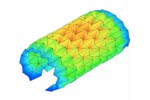Form Finding App Github
RELATED:
 ORIGAMI SIMULATOR
ORIGAMI SIMULATOR
 LOCKED LETTERS
LOCKED LETTERS
 AMOEBA
AMOEBA
 STRUCTURAL SIMULATIONS
STRUCTURAL SIMULATIONS
This interactive design tool simulates loading patterns and solves for the geometry of thin-shell structures under pure compression. Traditionally, shell form finding was achieved by creating physical models from cloth and string, loading them with hanging weights or other forces, and carefully measuring their geometry at equilibrium. Now, anyone can run form finding simulations from their laptop and design these forms virtually.
This tool implements both static and dynamic simulation methods to solve for shell geometry. The static simulation uses the force-density method to solve a linear system of equations for the steady-state equilibrium positions of every node in the system given a force density (force per unit length) at each edge. The dynamic simulation uses a mass-spring-damper system to model interactions between nodes through edges. By adjusting the topology and material properties of the structure, it is possible to achieve many diverse forms.
Live demo here, code on Github.

Hanging weighted chains will always fall to an equilibrium position in pure tension - by flipping this geometry over it will support downward loads with all its members in pure compression. The architect Antoni Gaudí built physical models like this to calculate the geometry of his buildings; this model is located in La Pedrera in Barcelona, Catalonia, Spain. Photo credit Valerie Hinojosa.

An example of a 3D printed model designed in the app. The reflection of the model shows the similarity to form finding techniques of the past - hanging weighted string/chain.

The thickness of each edge in the printed model is proportional to the internal force under uniform loading conditions.






